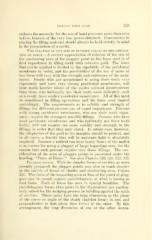Page 531 - My FlipBook
P. 531
FTLIJNd WTTTT riOT^Tl. 253
reduces the necessity for the use of hand pressure more than ever
before, because of the very free access ol)tained. Convenience in
placing the filling material should always be held strictly in mind
in the preparation of a cavity.
The relation of the size op plugger points to the applica-
tion OF force.—A correct appreciation of relation of the size of
the condensing area of the plugger ))oint to the force used is of
first importance in filling teeth witli cohesive gold. The force
that can be applied is limited l)y the capability of the peridental
membrane to resist, and the possibilities of the use of more or
less force will vary with the strength and endurance of the mem-
brane. People who are accustomed to using their teeth very
vigorously and have very strong peridental membranes, will
bear much heavier blows of the mallet without inconvenience
than those who habitually use their teeth more delicately, and,
as a result, have weaker peridental membranes. All of this must
be considered in filling operations and the force used limited
accordingly. The requirements as to solidity and strength of
fillings for different persons are of equal importance. Persons
with strong peridental membranes, who use their teeth vigor-
ously, require the strongest possible fillings. Persons who have
weak peridental membranes and who habitually use their teeth
feebly, will not require the same solidity and strength in the
fillings in order that they may stand. In either case, however,
the adaptation of the gold to the margins should be perfect, and
in all cases, a density that will be moisture-tight is absolutely
required. Because a patient can bear heavy blows of the mallet
is no excuse for using a plugger of large impacting area, for the
reason that such persons require very dense fillings. The con-
sideration of the area of plugger points is presented under the
heading, "Force of Blows." See also Figures 320, 321, 322, 323.
Plugger points. With the simpler forms of cavities as more
recently prepared, the plugger points may also be much simpler
in the variety of forms of shanks and condensing area. Figure
324. The form of the impacting area or face of the point of plug-
gers may be round, square, parallelogram, or what is known as
foot form. Each of these has uses in special localities. The
parallelogram forms (two pairs in the illustration) are particu-
larly suited for the wedging process in building against the walls
of cavities. These pairs have the long dimension in the plane
of the curve or angle of the shank (hatchet form) in one, and
perpendicular to that plane (hoe form) in the other. By this
arrangement, the long dimension of one or the other instru-


